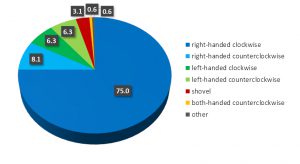Certainly, most of us enjoy an occasional nice bowl of spaghetti. Some of us use a spoon along with the fork, some don’t. Doesn’t matter, as long as you enjoy and don’t make a mess. But have you ever wondered whether there is a preferred direction to turn the fork? And is it related to where you live? We did!
In our last issue (Vol 2, 2018), we launched a survey asking our readers exactly this question (Figure 1).
Figure 1: The Spaghetti Turn survey as it appeared on the webpage.
Our survey was advertised in social media (Facebook, LinkedIn, Twitter, ResearchGate) and via QR codes on flyers. The survey reached a total number of n=160 readers, 132 of them found their way directly to our website. The results are shown in Table 1 and Figure 2.
Table 1: Results of the survey “The Spaghetti Turn”.
| Northern hemisphere | Southern hemisphere | worldwide | ||||
| n | % | n | % | n | % | |
| right-handed clockwise | 117 | 75.5 | 3 | 60 | 120 | 75.0 |
| right-handed counter clockwise | 12 | 7.7 | 1 | 20 | 13 | 8.1 |
| left-handed clockwise | 10 | 6.5 | 0 | 0 | 10 | 6.3 |
| left-handed counter clockwise | 10 | 6.5 | 0 | 0 | 10 | 6.3 |
| both-handed clockwise | 0 | 0 | 0 | 0 | 0 | 0 |
| both-handed counter clockwise | 1 | 0.6 | 0 | 0 | 1 | 0.6 |
| shovel | 4 | 2.6 | 1 | 20 | 5 | 3.1 |
| other | 1 | 0.6 | 0 | 0 | 1 | 0.6 |
| sum | 155 | 96.9 | 5 | 3.1 | 160 | 100 |
Figure 2: Worldwide percentage of the preferred direction to turn the fork when eating spaghetti related to the handedness (values in %).
The option „no preferred direction” remained unanswered. One single participant chose “I am right-handed and turn clockwise” and “I am right-handed and turn counter clockwise”, depicted as “other”. Assuming that this is no miss-click one out of a total number of 160 participants has no preferred direction when using the fork with their right hand. This underlines that most people on earth indeed have a favourite direction to screw the fork.
Although there is no clear definition to determine handedness, some publications claim that 70–95 % of human population worldwide are right-handed, 5–30% are left-handed and a small minority is ambidextrous.[1] This is consistent with our findings: the survey was answered by 133 right-handed people, which is 86.9% of all 154 participants who revealed their handedness. 20 participants are left-handed (13.1% of all 154 participants who revealed their handedness). One participant (<1%) is ambidextrous and turns the fork counter clockwise with both hands.
75.0% of all participants are right handed and turn the fork in clockwise direction. Only 8.1% turn it counter clockwise. Surprisingly, there seems to be no preference about the turning direction among left-handed people. Their numbers equal (each ten or 6.3%), while 90.2% of all right-handed people turn clockwise. Fortunately (or shockingly?), 3.1% of spaghetti eaters worldwide shovel.
Unfortunately, we did not reach a significant number of readers from the southern hemisphere. Four participants out of five are right-handed, one shovels. 60% of the right-handed southerners turn the fork clockwise, 20% turn it counter clockwise. Considered that only five participants (3.1% of all) do not represent the whole ~10% of the human population living on the southern hemisphere,[2] the preference of turning counter clockwise shows the same tendency for both hemispheres. There is therefore supposedly no relation to where you live on this planet.
But why is the clockwise direction so obviously favoured?
Time and therefore clocks have a powerful influence in our daily lives. Also, in a lot of cultures texts are written from left to right (as the clockhand moves). Moving and looking to the right is very often linked to the future and openness. An experiment from Sascha Topolinski and Peggy Sparenberg from 2012 suggests, that the preferred direction to turn objects could be determined by one’s conservative or open personality.[3] Or is it just for handling reasons only and it is a little easier to apply force on the edge of the fork while turning it clockwise?
With a simple survey like our’s it is impossible to determine whether the habit to turn the fork left or right is a matter of education, subconsciousness or technique.
Throughout the active survey it was possible to answer the poll via the Facebook “Surveys for Pages” and our webpage. Hence, we cannot entirely assure the integrity of the results. Also, we hope our readers understand humour but also answer the survey genuinely. We simply trust in the scientific spirit of our readers. We also did not consider that for cultural habits in certain cultures spaghetti dishes might not be available or forks might not be part of the traditional cutlery. Although it is very often a cause for heavy crossfires during meals, the use of a spoon along with the fork is discounted in the evaluation of the results too. With this survey we just aim to give a picture about the general turning behaviour of spaghetti eaters. To the best of our knowledge there has not been a similar survey until now.
We are now smarter than before but still missing the details of the big picture. Let’s see what the new year brings…
Tatjana Dänzer, Mariia Filianina, Alexander Kronenberg, Kai Litzius, Adrien Thurotte
The editorial team of the Journal of Unsolved Questions thanks all 160 participants of the survey and wishes Bon Appetit and a very happy start into the year 2019!
Read more:
[1] [https://www.scientificamerican.com/article/why-are-more-people-right/ (last access 31.12.18, 15:20).
[2] https://bigthink.com/strange-maps/563-pop-by-lat-and-pop-by-long?page=all (last access 31.12.18, 15:40).
[3] Sascha Topolinski, Peggy Sparenberg, Social Psychological and Personality Science, 2012, 3, 308–314.

